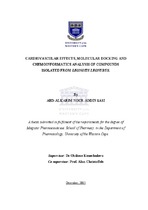| dc.description.abstract | Leonotis leonurus (L. Leonurus) has relatively abundant diterpenes and has been used as a traditional herbal medicine for treating several ailments including influenza, muscular cramps, skin related diseases, menstrual, antilipidemic, hyperglycaemia and hypertension. In this study, diterpenoid compounds such as; Dubiin, SaponifiedDubiin, Hispanol, Marrubiin and DC9 were isolated from L. Leonurus plant. The cardiovascular effects of these isolated compounds were investigated in order to determine the response of anaesthetised normotensive Wistar rats (in-vivo) to the compounds. Also, the druglikeness of the isolated diterpenoid compounds and their binding interaction with β1 adrenoceptor (PDB: 2Y04), angiotensin II receptor (Ang II) (PDB: 3R8A), Angiotensin converting enzyme (ACE) (PDB: 4XX3), and renin receptor (PDB: 2X8Z) by using molecular docking methods and Chemoinformatics analysis was performed (in-silico). Important molecular descriptors and molecular docking were used in our Chemoinformatics (in-silico) analysis to study the druglikeness and the binding affinity for of each molecule (Dubiin, SaponifiedDubiin, Hispanol, Marrubiin and DC9). The molecular descriptors and the binding energy were calculated by using the molecular operating environment software (MOE 2013). The lowest energy and highest cluster conformations of the molecules were further analysed. All the five (5) diterpenoids were predicted to have good oral bioavailability after oral administration and passed the BloodBrain Barrier (BBB) rules. Also, the compounds were predicted to have high probability of being good Druglike candidates, except for DC9, which is predicted to have lower possibilities of being Druglike candidate than the other diterpenoids. Furthermore, these compounds (Dubiin, SaponifiedDubiin,
Hispanol, Marrubiin and DC9) were shown to interact with β1 adrenoceptors in-silico, an interaction that was confirmed in-vivo by increases in Blood pressure (SP, DP and MAP) and Heart rate (HR). In anaesthetized normotensive male Wistar rats (in-vivo), Dubiin (0.5 40mg/kg; IV), SaponifiedDubiin (0.5 60mg/kg; IV) Hispanol (0.5 40mg/kg; IV), DC9 (0.5 40mg/kg; IV) and Marrubiin (0.5 40mg/kg; IV) produced dose dependent increase in Systolic pressure (SP), Diastolic pressure (DP), and Mean arterial pressure (MAP) at all doses. Also, the compounds produced dose dependent increase in Heart rate (HR). From the in-vivo and in-silico studies it can be concluded that all the five (5) isolated diterpenoid compounds showed cardiovascular effects on Blood pressure (BP) and Heart rate (HR) by acting as β1 adrenoceptor agonists. Also, these diterpenoids compounds could be responsible for the cardiovascular effect observed in the methanol extracts from
previous studies. These cardioactive compounds are prototype or ''lead compounds''
for designing and developing new nontoxic and effective drugs for cardiovascular disease (CVD) treatment. | en_US |

